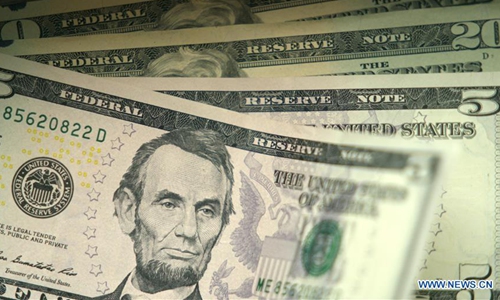Chinese currency gains value while the US dollar tumbles
By Zhang Dan Source: Global Times Published: 2020/8/4 15:05:05

Photo taken on March 3, 2020 shows US dollar banknotes in Washington D.C., the United States.(Xinhua/Liu Jie)
As the US Dollar Index (DXY) lost ground with a decade-low single month decline, analysts warned that the weak dollar cycle has started amid increasing uncertainties of the COVID-19 pandemic and the US presidential election.
An economist said that despite the US pressure, China will continue to push forward internationalization of its currency, the yuan, and the US crackdown may speed up the development of a new global payment system centered on the Chinese currency.
July saw the dollar's weakest monthly performance in a decade as the DXY, which measures the greenback against its main rivals, reported a drop of more than 4 percent, the biggest monthly drop since September 2010.
Analysts tied the weakness to a sharply contracting US economy hit hard by the pandemic.
"In March, the DXY saw an increase of 8 percent as COVID-19 wreaked havoc China and the virus situation was not serious in the US. However, in the following months, the US lost control of the virus, putting an end to hopes that the world's largest economy might recover in the third quarter," Lian Ping, chief economist at Zhixin Investment, told the Global Times.
Growing concerns over the state of the US economy - together with inter-party fighting, racial conflicts and some restrictive policies the US implemented for countries including China - led to a weakened DXY, and the trend may continue, Lian said.
He said that virus control, the US presidential election and competition with China will mean the currency will experience more ups and downs.
"As the US threatens to impose financial sanctions on China, it is possible that will force China to expand the use of its own global payment system with the yuan," Lian noted, adding that would push forward the Chinese currency's internationalization.
On Tuesday, the central parity rate of the renminbi strengthened 177 points to 6.9803 against the dollar, according to the China Foreign Exchange Trade System (CFETS).
To better facilitate trade with countries along the Belt and Road Initiative and reduce currency conversion costs, China in August lifted transaction fees for bidding and inquiries from 12 direct trading currencies for three years, including the Singapore dollar, the Russian ruble, the Malaysian ringgit and the New Zealand dollar, according to a statement from CFETS on Monday.
"Such efforts will help save settlement costs, as well as promote the internationalization of the renminbi and the development of China's foreign trade and economic cooperation," Liu Xuezhi, a macroeconomics expert at the Bank of Communications, told the Global Times.
In June, the renminbi proportion of foreign-related bill collections in banks on behalf of customers rose to 35 percent, up 13 percentage points from 2018, and the use of the renminbi in overseas payments grew to 39 percent, up 16 percentage points, according to the State Administration of Foreign Exchange. In contrast, the use of the US dollar in both cases fell more than 10 percentage points in the last two years.
While the dollar has weakened, the renminbi has not been performing as strongly as the euro, the pound and the yen. Lian attributed that to the US' irrational crackdown on China.
Investors may have concerns about the yuan due to US pressure, and that's why so many people have been buying gold.
"But we could do the opposite of what the US has done and will should continue to help more investors to hold more yuan assets," Lian suggested.
Posted in: ECONOMY